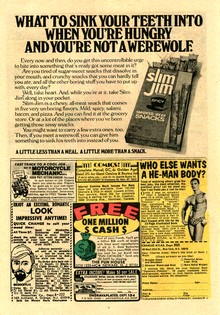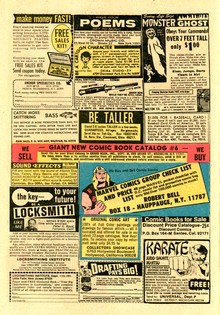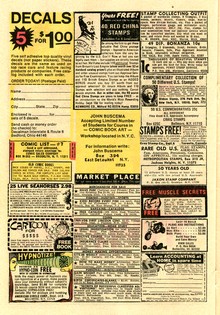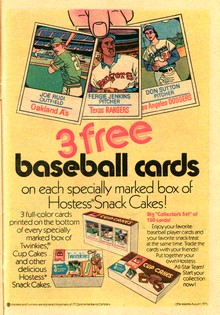 |
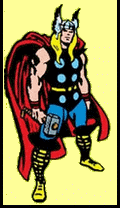 |
|
 SPOTLIGHT
ON SPOTLIGHT
ON
THE
FANTASTIC FOUR, SPIDER-MAN &
THOR
BACK
TO BACK IN A
SEPTEMBER 1975 MARVEL MULTI-MAGS
|
|
|
|
| |
|
FANTASTIC
FOUR#162
MARVEL
TEAM-UP #37
MIGHTY THOR
#239
|
|
 |
|
| |
|

|
|
| |
|
By
the mid-1970s, Marvel had fully embraced
the marketing concept of selling multiple comic
books packaged in a sealed plastic bag to a
customer base which comic books could hardly
reach otherwise: people shopping at supermarkets
and large grocery stores.
It didn't really
matter therefore that buying these three comic
books in a comicpack for 74¢ (rather than from a
newsagent for 75¢) clearly presented no real
bargain - it was the opportunity and convenience
to pick up a few comics at the same time parents
and adults did their general shopping. Neatly
packaged, it almost became an entirely different
class of commodity.
The MARVEL MULTI-MAGS we are
looking at here features three titles from the
September 1975 cover date run (meaning they were
actually on sale in June 1975): Fantastic
Four #162, Marvel Team-Up #37, and Mighty
Thor #239.
There
is no general rule to state what shape/grade the
comic books in a MARVEL MULTI-MAGS (or any other comic pack for
that matter) will be in. After all, a lot of
things can go wrong during their 40+ years of
storage.
Some
of these potential mishaps will only affect the
plastic bag, others might not harm the packaging
as much as the contents. As a result, almost any
combination is possible: you can have a polybag
displaying lots of wear but perfect comic books
inside (meaning it was mostly stored in a dark
and cool place but at some time took some
external soiling or slight mechanical abrasion),
but you can just as well have a near pristine
polybag holding comic books showing substantial
paper degradation (indicating the bag was stored
well but exposed to light and excessive warmth
for an extended period of time).
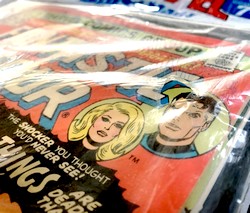 |
|
Given its age, the polybag of
this September 1975 MARVEL
MULTI-MAGS is rather clean in comparison
to some packagings of the same period,
with only slight dulling of the plastic
and a few spots of light colour ink
residue (blue and red) from when the
label was turned back onto the bag during
some time of storage (a common defect
found on many comicpack bags which
usually doesn't affect the comic books
inside the bag).
There is only one sign of
physical wear - a fairly small tear an
inch or so below the sealing line of the
label.
|
However, this slight
wear of the bag did not, fortunately, harm its
contents; the three individual comic books inside
proved to be in excellent overall condition:
pristine covers with perfect gloss and shine,
perfectly flat and tight (without any spine
stress or major creases), sharp edges, and
off-white pages.
No titles had
permanent slots in the MARVEL MULTI-MAGS, but all three titles
contained in this example - Fantastic Four,
Marvel Team-Up and Thor -
featured often and regularly.
|
|
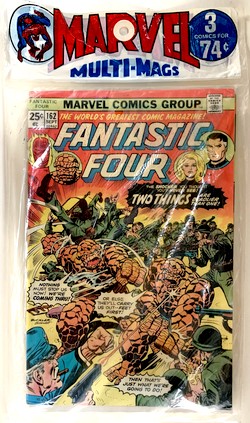
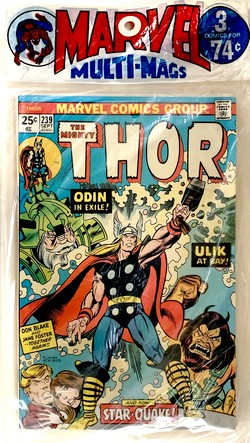
|
|
| |
| But even so, given the
sometimes seemingly haphazard way individual issues were
selected for inclusion in MARVEL MULTI-MAGS, there was no guarantee of an uninterrupted
flow of consecutive issues - and therefore a distinct
possibility of missing out on a part of the storyline. On
top of this, the continuity of the Marvel Universe of the
1970s was such that plots and storylines usually evolved
over more than one issue.
This didn't exactly make the MULTI-MAGS an ideal way of getting your
Marvel comic book fix. However,
one needs to bear in mind that this was a common fate of
the average comic book reader in the 1970s Bronze Age,
whether his or her comic books came packaged in a plastic
bag or as single issues from a display or spinner rack.
Back in those days, an uninterrupted supply of specific
titles simply was not guaranteed. Not worrying too much
about possible gaps in storylines became something of a
routine - besides, you would usually get a recap of what
had happened so far on the first page.
So all in
all it simply was a part of being a comic book fan in the
1970s - just as the monthly Bullpen Bulletins (which were
the responsibility of the editor-in-chief) and the
in-house advertising were.
The September 1975 Bullpen
Bulletin ("A frantic, frenetic, fun-filled foray
into the fable-fraught fortress of fandom's favorite
fraternity!") featured a verbose announcement
by Stan Lee in his regular SOAPBOX
column of an upcoming Treasury Edition of the Wizard
of Oz. What Lee failed to mention was that this
somewhat unusual foray into classic children's novel
material (albeit heralded by Lee as "a fairy
tale written for a thinking adult, with all the fantasy,
the drama, the grandeur and the thrills of a thousand
superhero sagas") actually was the first time
ever that Marvel and DC teamed up as publishers -
although more out of sound business sense than anything
else.
|
| |
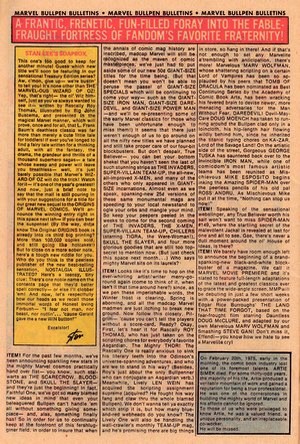 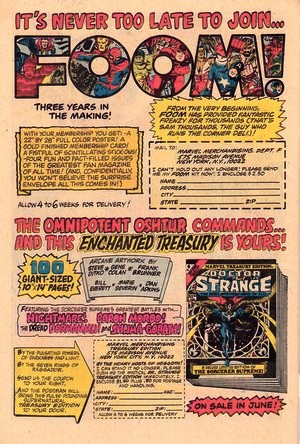 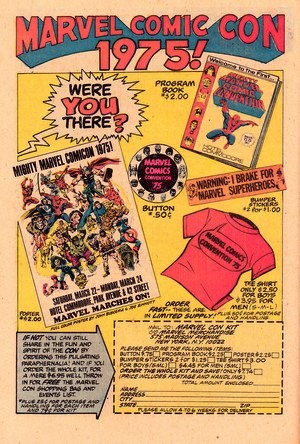 |
| |
| Frank L. Baum's book featuring Dorothy, the
Scarecrow, the Tin Man and the Cowardly Lion (first
published in 1910) had been in the public domain since
1956, and since that meant a royalty-free adaptation,
Marvel decided to have a go at it. Stan Lee picked Roy
Thomas for the writing, John Buscema for pencils, and
Tony DeZuniga for inks, but it wasn't long into the
production of Wizard of Oz that Lee became aware
of the fact that DC had come up with the same idea
roughly at the same time - but DC had actually paid MGM
for the rights to adapt the movie. It was clear that two
competing adaptations would provide no publisher with
much of a profit, so Stan Lee met with Carmine Infantino
to see if DC was open to striking a deal. They came to an
agreement to create a single 82-page oversized comic
which would carry the title Marvel and DC Present
MGM's Marvelous Wizard of Oz. Since Thomas and
Buscema continued their work, it really was a Marvel
production and DC was just taking a piece of the sales
action through their movie rights, but it worked out
financially for both parties involved - and in a way
probably opened the door for the cross-publisher
superhero titles (Faraci, 2020). As
for the actual Bullpen Bulletins, the first of the various ITEM!
bullet points talked about the non-publication of some
previously announced 50¢
Giant-Size titles.
|
| |
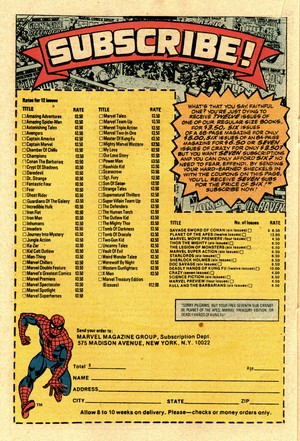
|
|
Marvel
was precariously overextending itself in
a continued attempt to push the
competition off the newsagent racks by
flooding them with its own product - but,
as readers were told in the typical
Marvel style:
"it
seems that there just weren't enough
of us to go around on all the nifty
new titles we have planned and still
take proper care of our four-bit
blockbusters. But don't despair, True
Believer (...) keep your peepers
peeled in the weeks to come".
The other ITEM! bullet
points were chiefly concerned with new scripting and art
assignments on various titles , and a
special announcement box broke the news
to readers of the passing of Artie Simek (6
January 1916 - 20
February 1975),
letterer supreme:
"He
was one of the cornerstones in
building the mighty world of Marvel
and his efforts cannot be
ignored".
The problem of Marvel
creating a hyperinflation of titles was
mirrored in a full-page in-house ad
promoting subscriptions, which featured
no less than an astonishing 63 colour
titles plus 14 black & white
magazines. In comparison, DC Comics had
38 colour titles to offer newsagents in
mid-1975 (September cover date production
run). Marvel was clearly winning the
numbers game, but it wasn't sustainable
and would continue to cause massive
headaches for its editors over the next
two to three years as issues could not be
finished on time.
|
|
|
| |
| Also included in all three
comics collected in this MARVEL MULTI-MAGS
was a combined FOOM / Giant-Size Doctor Strange
in-house advert, as well as a 1975 Marvel Comic-Con
merchandising ad. |
| |
|
| |
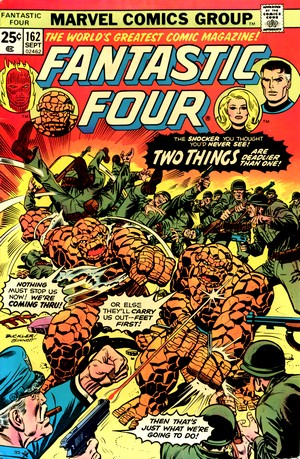
|
|
FANTASTIC
FOUR #162
September 1975
(monthly)
On Sale: 24 June 1975
Editor
- Roy Thomas
Cover - Rich Buckler (pencils) & Joe
Sinnott (inks)
"The Shape of Things to
Come!" (18
pages)
Story - Roy
Thomas
Pencils - Rich Buckler
Inks (credited) - Joe Sinnott
Inks (uncredited)* - Dan Adkins (last two
pages)
Lettering - Joe Rosen
Colouring - Phil Rachelson
* uncredited
contribution as per this issue's creative
talent information on comics.org
Synopsis
! SPOILER ALERT !
This story
continues from Fantastic Four
#160-161 and takes place in three
parallel worlds: The world of the
Fantastic Four (i.e. the planet Earth we
know), an Alternate Earth
("Earth-A"), and an "Earth
of the 5th Dimension".
|
|
|
| |
| Arkon, warlord and ruler of
the extra-dimensional world of Polemachus, has started to
orchestrate events causing three different realities to
attack each other. Having previously acquired technology
from all three worlds involved, Arkon has had his agents
attack the 5th Dimension with Earth-A's Andrones; Earth-A
is under attack from beings from other time periods
(transported there by using Dr. Doom's time machine); and
lastly, our Earth is starting to be turned into a frozen
wasteland by using the 5th Dimension's freezing
technology. |
| |
| The events have a special
twist to them as certain parallels to the
Fantastic Four of our world exist on Earth-A
(where Reed Richards is actually the Thing) and
the Human Torch (of our earth) is helping out the
5th Dimension's Android Force.. Mr Fantastic learns of
all this as he is "mind linked" by the
Reed Richards of Earth-A. Combining their mental
strength allows Earth-A Richards to free himself
from Arkon's captivity. When the Earth-A Richards
also learns that the FF-Thing is also held
captive on Earth-A he breaks out his lookalike,
and together the two Things face a battalion led
by Earth-A's version of General Ross.
To complicate matters
further, a portal to the 5th Dimension opens up
with the Human Torch leading an invasion force
into Earth-A's realm.
|
|
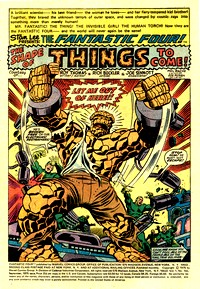 |
|
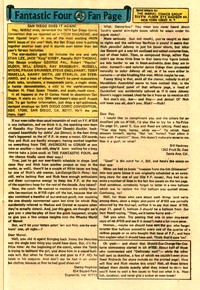 |
|
| |
| Although seeing two Things is a confusing sight
to Johnny Storm, he understands what is going on after
some explanations and in turn manages to convince the
people of the 5th Dimension to return to their own world
and await a solution to the situation. Meanwhile Arkon's
plan is unravelling, as FF-Richards explains to all
parties involved that the ultimate goal of leading the
three worlds to go to war with one another was to trigger
nuclear strikes on all three worlds. The resulting
combined nuclear holocausts would create sufficient
nuclear energy through a dimensional Nexus to revitalize
Arkon's world. Putting a stop to these plans requires
closing the dimensional rift, but only one person can
enter the realm where the Nexus resides. As the FF-Thing
heads towards the Nexus he finds a lone guardian in his
way. To be continued...
This (in spite of its
length actually somewhat compressed) synopsis clearly
shows that there is a lot going on here - and it involves
three different planes of reality, no less. The concept
of "parallel earths" was introduced to comic
books by Gardner
F. Fox in his famous "Flash of Two Worlds"
story (Flash #123)
in September 1961, and DC has made extensive use of its
"multiverse" ever since. Marvel, on the other
hand, rarely explored parallel realities with characters
which are the same yet different (which at face value is
a strange concept anyway), so this foray is something of
an exception. It is probably also no coincidence that Roy
Thomas was at the helm of this storyline, given his known
soft spot for DC's Golden Age history. And Thomas handles
it well - a clear plot leaves little room for confusion,
and just to be on the safe side, he and Rich Buckler even
provide two charts to literally "sketch it out"
for readers.
|
| |
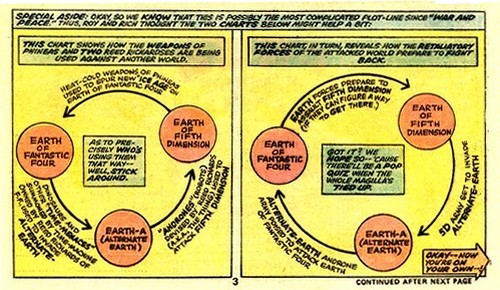 |
|
As a nice
additional touch, Buckler makes it easy for us to
distinguish which Thing is which, as the
"Earth-A" Thing wears brown pants (in
contrast to Ben Grimm's famous blue ones) and
also sports a torn shirt (which would even make
the visual differentiation possible with later
black and white reprints).
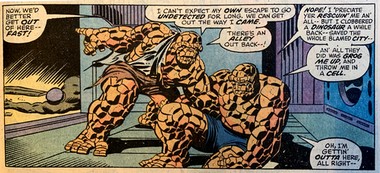
|
|
| |
| At face value, Fantastic Four
#162 would seem to be a less than ideal issue to
find in a MARVEL MULTI-MAGS, given
that it contains part 3 of a four-part story arc, but
that was the magic of Marvel Comics in the 1960s and
1970s - you could still get lucky and enjoy a fast paced
and entertaining single issue without ever seeing any of
what went on before or after. And Fantastic Four #162
is exactly that kind of comic book. |
| |
|
| |
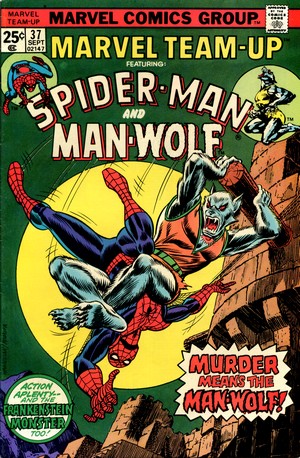
|
|
MARVEL
TEAM-UP #37
September
1975
(monthly)
On Sale:
24 June
1975
Editor - Marv
Wolfman
Cover - Ed Hannigan (pencils)
& John Romita (inks)
"Snow
Death!"
(18 pages)
Story
- Gerry Conway
Pencils - Sal Buscema
Inks - Vince Colletta
Lettering -
Karen Mantlo
Colouring - Phil Rachelson
Synopsis
!
SPOILER ALERT !
This story
continues from the previous
issue, Marvel Team-Up
#36, in which Spider-Man is
mysteriously teleported by Baron Ludwig Von Shtupf
("you may call me the
Monster Maker") to his
remote castle somewhere in
Europe, where Spidey is held
captive alongside the
Frankenstein Monster and
Man-Wolf. Also in the fold is a
team of S.H.I.E.L.D. operatives
who are out to foil Von Shtupf's
evil plans.
|
|
|
|
| |
| After an all-out clash
between Spider-Man, the Frankenstein Monster and
Man-Wolf, Von Shtupf reveals his plan: breaking
down Spider-Man, the Frankenstein Monster, and Man-Wolf
with a "dissector device" into their base
components in order to combine their individual abilities
and create an army of monsters from this
"essence". But in the end, Spidey and the Monster overwhelm the
mad Baron, and after yet another fight between the
webslinger and the Man-Wolf the latter disappears into
the wild, Spidey and the S.H.I.E.L.D. agents take a
helicopter back to civilization, and the Monster walks
off into the remote mountains all alone.

Not a very original plot idea by
any standards,
it is at
least in-tune with the appearance of the Frankenstein
Monster and Man-Wolf and does resemble a B-movie of the
genre quite a bit. There is also some humour creeping in
when the S.H.I.E.L.D. agent tells Spider-Man and the
Monster "This operation will require stealth.
You're too much on the obvious side."
Some of the Baron's rather whacky
contraptions (such as how exactly he teleported everybody
to his castle or just how he plans to combine the three
protagonists by cutting them up with what looks like a
laser) are never even given an attempt of an explanation,
but Gerry Conway just about manages to keep everything
from falling apart. There is also a small dose of Marvel
morals when at the end, as Man-Wolf is taken into
S.H.I.E.L.D. custody, Spider-Man talks about how hard it
must be "for somebody to love a monster", not
realizing that the Frankenstein Monster hears what he
says - Spider-Man doesn't realize the damage he's done
until after he and the agents notice that the Monster is
not aboard the S.H.I.E.L.D. ship when it lifts off.
|
| |
|
If the story is somewhat
reminiscent of a B-movie, then the art definitely
is below average - which is rather odd, given
that the artist is Sal Buscema (whose wonderful
pencils could be sampled in the Thor
issue also contained in this very MARVEL
MULTI-MAGS). So what happened? Actually,
the answer points more in the direction of
"who" rather than "what". Vince "Vinnie"
Colletta (1923-1991) is possibly the most
prolific and at the same time most controversial
inker the comic book industry has ever seen. He
could be extremely fast with his work and was
almost any editor's go-to-inker when a title was
running late, and he always delivered (Bryant
Jr., 2010). The downside to this was the fact
that Colletta would at times cut corners by
erasing details in the pencil artwork and
simplifying panels. It helped to meet deadlines
and avoid having to pay hefty printer's fines,
but not all artists were too happy with it.
|
|
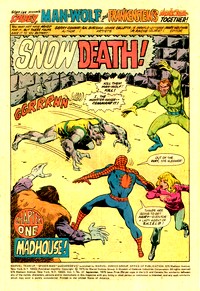 |
|
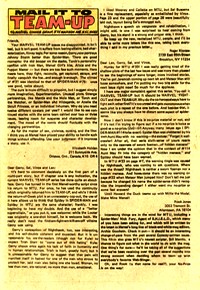 |
|
| |
"Vince
wrecked what I did (...) He would eliminate people
from the strip and use silhouettes, everything to cut
corners and make the work easier for himself."
(Joe Sinnott in Ro, 2004)
"When he wanted to he
could do very good work, but he didn't take his time
with my stuff." (Gene Colan in Field, 2005)
Editors and writers often
weren't too impressed either. Stan Lee dropped Colletta
as inker for Tomb of Dracula after he felt that
he had taken too many shortcuts on issue #9 (Field,
2005), and Len Wein famously stated (when asked in an
interview what he enjoyed most about working on Luke
Cage):
"Getting to work with the wonderful
George Tuska, before Vinnie Colletta got his hands on
the pencils and ruined them." (Contino,
2005)
But Marvel Team-Up
suffered other, more systemic problems, too - as a glance
at the letters page clearly shows. While
the team-up formula was a novelty when the title started
back in 1971, the stories quickly became highly
formulaic with more misunderstandings between the good
guys and therefore in-fights than one could count (and
ultimately stomach). Readers seemingly also wanted more
of a continuous plot rather than "done in one
issue" stories (two in this case here). It would
remain a problem for Marvel Team-Up, even though
the title racked up a total of 150 issues before bowing
out in early 1985.
|
| |
| |
|
| |
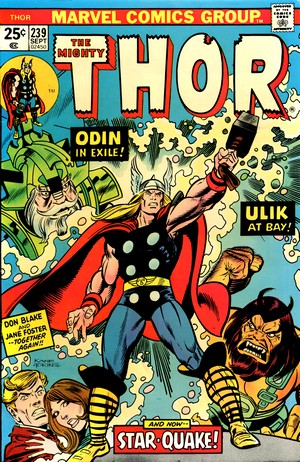
|
|
MIGHTY
THOR #239
September
1975
(monthly)
On Sale: 10 June 1975
Editor - Roy
Thomas
Cover - Gil Kane (pencils) &
Dan Adkins(inks)
"Time
Quake!" (18
pages)
Story - Roy
Thomas
Pencils - Sal Buscema
Inks - Joe Sinnott
Lettering - John Costanza
Colouring - Phil Rachelson
Synopsis
!
SPOILER ALERT !
Having
defeated Geirrodur, the rock
troll king, Ulik sets his sights
on the surface world. But Thor
not only defeats both Ulik and
his plans, he also causes the
underground cave to collapse on
the trolls while he and Jane
Foster safely escape to the
surface.
Meanwhile,
in California, Odin (who goes by
the name of Orrin since he can't
recall who he actually is) takes
part in a strike meeting with his
fellow farm workers when a
gigantic pyramid bursts up from
the ground.
|
|
|
|
| |
| Transfixed by it, Orrin/Odin
ascends its steps when Osiris, Isis, and Horus appear in
an opening doorway - all of which is witnessed by Jane on
TV as Thor has left to search for Odin. The issue ends
with Orrin/Odin following the three gods of Ancient Egypt
into the pyramid... to be continued. |
| |
Thor #239 saw Roy Thomas
take over the scripting from Gerry Conway, but
what had been planned as a longer assignment
would be cut very short, as an opening message on
the letters page pointed out.
"In this
issue, it was our original intention to
announce that Roy Thomas planned to pull
himself away from the likes of the Fantastic
Four, Conan, and the new-but-nostalgic
Invaders to take up full-time scripting and
editing reins of THOR. However, by the time
the story called "Time-Quake" was
finished, it was already apparent that the
Rascally One was going to be too busy to
continue as a regular writer on the mag,
despite the fact that he's been waiting years
for a crack at writing it. Several projects
have since beckoned."
|
|
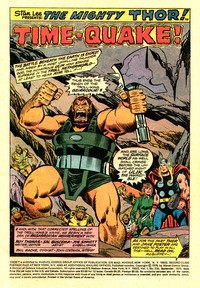 |
|
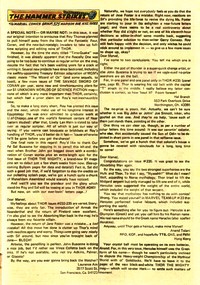 |
|
| |
| Readers were told that one of
these projects was the "swiftly-upcoming
Treasury Edition adaptation of MGM's classic movie
"The Wizard of Oz" (and some sequels, to
boot)". Marvel was clearly down to the wire,
with what seemed like an endless list of projects and not
really enough creative talent to go around and make it
happen. |
| |
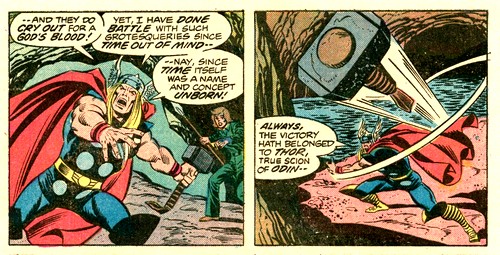 |
|
"So,
to make a long story short, Roy has plotted
this issue and the next (...) after that,
Lively Len Wein is slated to take over as
regular scriptor."
But
the message didn't stop there.
"Roy'd
like to thank Our Pal Sal Buscema for
stepping in to pencil this ish and the next
when Brother John got bogged down with a
combination of Conan stories plus an
extra-length epic for the first issue of THOR
THE MIGHTY, a brand new $1 magazine set to
debut just a few short weeks from now."
|
|
| |
| It was quite clear that editors
were frantically shuffling around writers, pencillers and
inkers in order to not fall too far behind on everything.
With hindsight, comic book historians would note that
this was a period when Marvel was beginning to seriously
mess up its line of titles due to an almost impossible
production line. |
| |
And the management board just
kept on calling for more.
"If we even
talked about an idea for a book it
immediately had to go onto a schedule and be
out a few months later." (Roy
Thomas in Howe, 2012).
The bottom line would be
that more and more titles would not reach their
sales points on time.
Sal Buscema proved a
worthy stand-in for his older brother and not
only provided a dynamic rendition of a well-paced
Roy Thomas story, he also managed to fit in
several iconic scenes, such as the transformation
of Don Blake into Thor and back again.
This is comic book
entertainment at its best - and looking at these
panels and then comparing them to Marvel
Team-Up #37 is also an indication of the
damning effect Vince Coletta's simplified inking
could have in watering down pencil artwork.
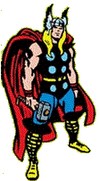
|
|
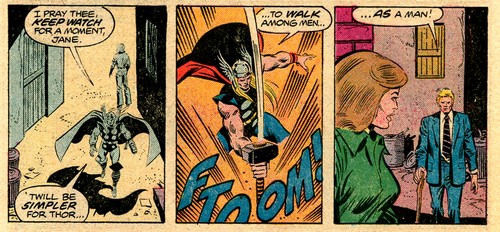
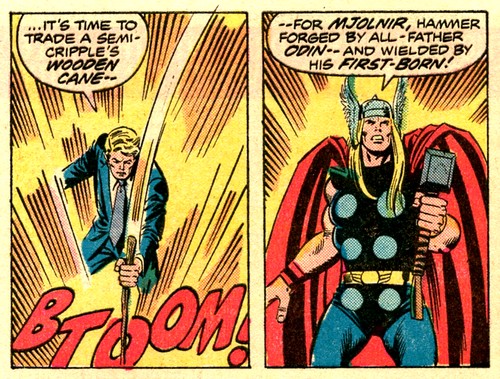
|
|
| |
|
| |
| No 1970's
Marvel comic book was, of course, without (a lot of)
third party advertising, some of which was
"okay" (mostly if it featured Marvel
characters) and some of which was nothing but a dismal
swamp of the cheapest form of advertising you could find
- such as the infamous flea market ads promising anything
and everything. All three titles included in this
September 1975 Multi-Mag carried exactly the same ads,
some of which are illustrated here. |
| |
|
| |
|
 |
|
Today, MARVEL
MULTI-MAGS are first and
foremost a time capsule; opening
that plastic bag offers a
nostalgic glimpse into what it
was like to be a comic book
reader in the 1970s. And
then as now, the combination of
the three titles in these sealed
polybags could go either way.
Sometimes it's all thrills, and
sometimes there's a lemon (or
two, if you're really unlucky) in
there. |
|
|
|
| |
|
This
September 1975 MARVEL
MULTI-MAGS
would, I am pretty certain, have thrilled my
socks off back in the days. And it still leaves
me with a "wow-feeling" today, although
maybe a little bit less so with regard to Marvel
Team-Up issue. While it isn't really bad, it
is definitely very pedestrian even for a
mid-1970s comic book. The Frankenstein Monster
was a favourite of mine back then, so this combo
with Spider-Man would have been right up my
alley. Today, that spark doesn't fly quite as
easily.
On
the other hand, both the Fantastic Four
and Thor issues are a pure delight even
today. Fast plotting and a storyline with a
purpose combine with artwork that just sucks you
in. It's the most fun you can have reading a
comic book - and in a way it also shows what is
lacking in today's comic books. But that's an
entirely different story for some other day...
|
|
|
| |
|
FURTHER
READING ON THE THOUGHT
BALLOON |
| |
 |
|
The
Frankenstein Monster's own title
was cancelled after 18 issues the
same month that Marvel
Team-Up #37 hit the
newsagent stands; you can read
more about Marvel's Monster
of Frankenstein title here. |
|
|
|
| |
 |
|
Back in 2010
I took a comparative look at two
issues of Fantastic Four separated
by no less than 33 years of real
time: #186 and #580. While a lot
of change has since been wrought
on Marvel's first family
(including cancellation of the
title for a year in 2015), you
can see the differences between a
1977 and 2010 comic book here. |
|
|
|
| |
|
| |
| BIBLIOGRAPHY BRYANT JR. Robert L.
(2010) The Thin Black Line: Perspectives on Vince
Colletta, TwoMorrows Publishing
CONTINO Jennifer
M. (2005) " Englehart, Isabella, Wein & Luke
Cage: An Essential Interview", The Pulse, online at
comicon.com (5 July 2005) [retrieved from
web.archive.org]
FARACI Derek
(2020) "How The Wizard of Oz Brought DC & Marvel
Together For Their First Crossover", online at cbr.com (25 February 2020)
FIELD Tom (2005)
Secrets
in the Shadows: The Art & Life of Gene Colan,
TwoMorrows Publishing
HOWE Sean (2012) Marvel
Comics: The Untold Story, Harper Collins
RO Ronin [Marc Flores]
(2004) Tales To Astonish: Jack Kirby, Stan Lee and
the American Comic Book Revolution, Bloosmbury
|
| |
|
| |
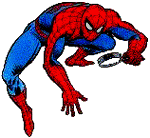
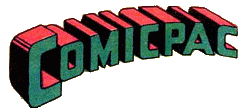
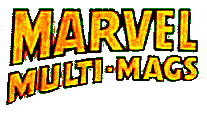
More on comic packs / More on Marvel Multi-Mags
|
| |
|
| |

(c) 2021
uploaded
to the web 11 April 2021
minor corrections 22 June 2024
|
| |
|
| |
|



























